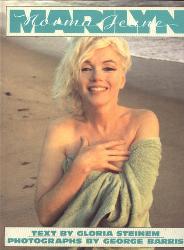
At the start of the 1980’s I had the pleasure of having my own Marilyn Monroe fan club which I called The Marilyn Monroe Bureau. I was a teenager and was quite creative and enjoyed putting fanzines together and felt Marilyn needed one as there wasn’t any fan clubs for her apart from the one run by Ernie Garcia in California.It was moderately successful for a few years and I produced a bi-monthly fanzine and had items to sell like Japanese books and other items, which I got from a dealer in London.
A few years passed and it seemed for a while that there wasn’t much happening in regards to Marilyn, there was very little in the way of books or mention of her and to me it seemed pointless to carry on as memberships dwindled. Eventually the fan club folded and I went on with my life.
However, after about a year or so things really took off again for Marilyn. Madonna had came onto the scene as the “new” Marilyn and she produced a homage to her idol at the time with a video for her song ‘Material Girl,’ which was a very direct salute to Marilyn’s ‘Diamonds Are A Girls Best Friend.’ A new biography was published, ‘Goddess: The Secret Life Of Marilyn Monroe’ by Anthony Summers which quickly became top of the best sellers list and Marilyn was once again on news channels and the cover of magazines!
To cap that the BBC produced an award winning documentary on the basis of that book called, ‘Say Goodbye To The President.’ It just seemed Marilyn was everywhere and the books and magazines continued at an even pace.
One of the most memorable books from this time was by feminist and writer, Gloria Steinem. One of the founders of Ms. Magazine and author of a previous essay on Marilyn called The Woman Who Died Too Soon. She had been approached by Dave Seaver, president of the Henry Holt and Company, who was looking for a writer to help explain Marilyn as an individual and as an icon of continuing power.
The goal for the project, therefore, would be closer to that of feminism in general and to include viewpoints of both women and men, and thus have a better chance of seeing one woman’s life as a whole.The book is a series of essays with some chronology to the order of chapters, with themes repeated from different viewpoints so that a factual and emotional holograph of the real person begins to emerge.Steinem sourced previous Marilyn biographies for much of her research into Marilyn’s life and death and relied heavily on Fred Lawrence Guiles’s ‘Legend: The Life And Death Of Marilyn Monroe,’and the Summer’s biography.
She has also tried to use quotes from Marilyn from her interviews with George Barris (whose photographs illustrate this book) and numerous other sources which were published over the years. There’s some good anecdotes about Marilyn’s love of children and her fascination with books.
It’s an interesting book for the time it was released but since then there’s been so much more information published about Marilyn’s life that it seems quite dated in places. One wonders what type of book Steinem may write now with so much more to go on and reflect on as years have passed and Marilyn’s legend and status have continued to retain it’s power and status.
By Fraser Penney






